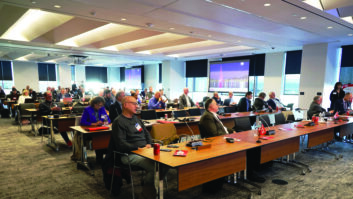 The author is membership program director of the National Federation of Community Broadcasters. NFCB commentaries are featured regularly at www.radioworld.com.
The author is membership program director of the National Federation of Community Broadcasters. NFCB commentaries are featured regularly at www.radioworld.com.
Many cities and states are reaching the conclusion of their stay-at-home period. Whether that period is extended or not, community radio stations need to start planning what they will and need to do when their communities reopen.
Virtually every community radio station has been affected in some way by the coronavirus. From complete switches to automation systems to staggering staff and volunteer presence for health and safety, community radio has had to adapt during this extraordinary time. Our programming and community service have been impacted. And, though we all crave getting back to what we love to do, community radio stations have to be especially diligent, considering their many constituents, volunteers and donors.
Pres. Trump has said in recent press statements that he intends to defer to the states, though he’s also expressed his desire to restart the economy amid growing unemployment. Many states indicate they will approach the reopening of businesses and public spaces with caution.
[Read: Community Broadcaster: Tips for Better Home Recordings]
How will community media organizations that have been on reduced operating and programming capacity return to normal operations?
You should strongly consider again reviewing existing documentation on these issues, as well as advice from federal, state and county officials. Communicating with those on the frontline is going to give you the most informed look at what your city is facing, and the risks to your staff and volunteers. Those leaders may say it’s too risky right now, or may involve you as part of phased returns.
In March, the Occupational Safety and Health Administration issued an excellent guide for preparing workplaces for COVID-19. Though it came out before the peak of public awareness, its lessons are important for everyone. At the top of the list is developing an infectious disease emergency plan, in the event of an outbreak. Your station’s plans should consider and address the level of risk associated with various areas of your building and the tasks staff and volunteers perform there.
For example, a locked engineering room is unlikely to have a lot of foot traffic and volunteer presence. Your live studio will have both. Will you be open to the general public to come in? Should on-air volunteers come back all at once, or in waves? How can your station put cleaning and other safety rules in before reopening fully? How can you educate your staff and volunteers about the new normal, at least for the foreseeable future?
The Centers for Disease Control and Prevention recommends ongoing safety protocols like face masks and social distancing. It also suggests a standard for sick individuals in order to prevent the spread of the coronavirus.
In this context, your station will also want to consider the welfare of its volunteers, staff and visitors. Whether and where people came from after travel and if they are in vulnerable populations may be significant if they are coming to your station. If your station has been dependent on preproduced programming, what programming can continue to be preproduced and what needs to be live in the studio? And how can you respectfully include those volunteers who still do not feel safe or are in an at-risk group?
Even during the COVID-19 pandemic, radio has been a trusted service. So, our return to business must come with an appreciation for the faith listeners put in us. Our returns must thus come with attention, care and compassion.












